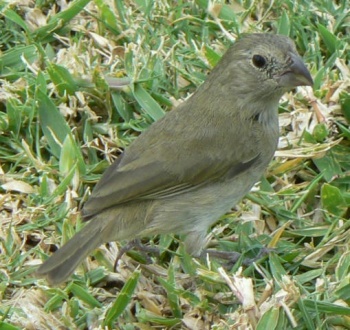- Melanospiza bicolor
Tiaris bicolor
Identification
10·2–11·5 cm (4-4½ in)
The male has a black head and breast, gray flanks and undertail coverts, and olive green upperparts; bill is black while the legs are reddish.
The female has upperparts that are similar to the male, and is slightly lighter on the underside than the upperside.
Judging from photos, the bill color is variable among subspecies.
Distribution
Breeds from Bahamas throughout the Caribbean to northern Venezuela and large parts of Colombia.
Accidental vagrant to southern Florida.
Taxonomy
This species has been placed in genus Tiaris in the past.
Subspecies
This is a polytypic species: eight subspecies are recognized[1]:
- M. b. bicolor: Bahamas and cays off Las Villas Province (Cuba)
- M. b. marchii: Jamaica, Hispaniola and adjacent islands
- M. b. omissa: Puerto Rico, Tobago, Isla Margarita, northern Colombia and northern Venezuela
- M. b. huilae: South-central Colombia (upper Magdalena Valley)
- M. b. grandior: Islas Providéncia, Santa Catalina and San Andrés (western Caribbean Sea)
- M. b. johnstonei: Isla La Blanquilla and Islas Los Hermanos (off Venezuela)
- M. b. sharpei: Netherlands Antilles (Aruba, Curaçao and Bonaire)
- M. b. tortugensis: Isla La Tortuga (off Venezuela)
Habitat
Black-faced Grassquit is found in areas with grass, and makes its nest in such an area. It will also live in gardens and forest edges, as long as seed-bearing grass is found nearby.
Behaviour
Breeding
Both adults build a domed grass nest, lined with fine grasses, placed low in a bush or on a bank. The clutch contains 2-3 whitish eggs blotched with reddish brown. The young are fed by both parents.
Diet
The diet consits mainly of grass and weed seeds.
References
- Clements, J. F., T. S. Schulenberg, M. J. Iliff, S. M. Billerman, T. A. Fredericks, B. L. Sullivan, and C. L. Wood. 2019. The eBird/Clements Checklist of Birds of the World: v2019. Downloaded from http://www.birds.cornell.edu/clementschecklist/download/
- Rising, J. D. (2020). Black-faced Grassquit (Melanospiza bicolor), version 1.0. In Birds of the World (J. del Hoyo, A. Elliott, J. Sargatal, D. A. Christie, and E. de Juana, Editors). Cornell Lab of Ornithology, Ithaca, NY, USA. https://doi.org/10.2173/bow.bkfgra.01
Recommended Citation
- BirdForum Opus contributors. (2024) Black-faced Grassquit. In: BirdForum, the forum for wild birds and birding. Retrieved 23 April 2024 from https://www.birdforum.net/opus/Black-faced_Grassquit
External Links
GSearch checked for 2020 platform.1






